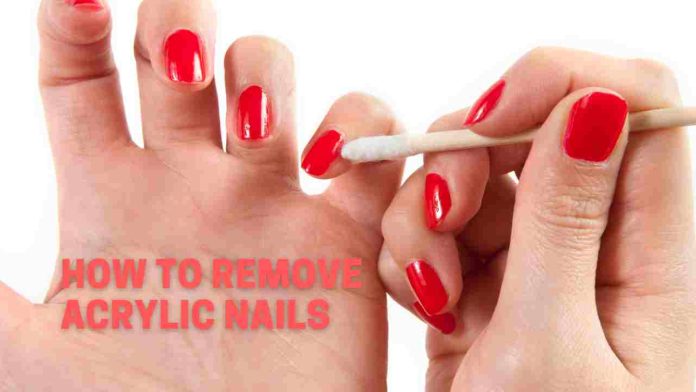Acrylic nails are very popular choice for those who want to improve the appearance of their natural nails. They provide added length, strength, and a variety of design options. However, there comes a time when you’ll want to remove them, either due to nail growth or desire to switch up to a new look.
The Ultimate Guide to Safely Removing Acrylic Nails at Home
To remove acrylic nails, trim and buff them first. Soak your fingertips in 100% pure acetone for 20-30 minutes. Gently scrape off softened acrylic using a cuticle pusher. Buff and shape natural nails, then moisturize with cuticle oil. Practice patience and care to avoid damage.
Although it’s always best to visit a professional nail technician for this process, One can safely remove acrylic nails at home if you follow the steps shown below. This in-depth guide will walk you through the entire process, so you can confidently remove acrylic nails without harming your natural nails.
- Gather Your Supplies
Before you can begin, make sure to get all the necessary supplies & tools at hand. You will require the following:
- 100% pure acetone
- Nail clippers
- A glass or ceramic bowl
- A larger bowl (for warm water)
- Aluminum foil
- Cotton balls
- Nail buffer or file
- Cuticle oil or moisturizer
- A wooden or metal cuticle pusher
- Tweezers
- Nail strengthener (optional)
- Prepare Your Nails
To start, you’ll want to trim your acrylic nails down as short as possible. This will make the removal process quicker and easier. Use nail clippers to carefully trim each nail, being cautious not to cut your natural nails beneath the acrylic.
Next, gently buff the surface of your acrylic nails with a nail file or buffer. This will help to remove top layer of nail polish or nail art, making it easier for acetone to penetrate and dissolve acrylic quickly.
- 3. Soak Your Nails
Pour some warm water into the larger bowl and place the smaller glass or ceramic bowl inside. The warm water will help heat the acetone and speed up the removal process. Fill the smaller bowl with enough 100% pure acetone to submerge your nails completely.
Before you proceed with soaking the nails, You must protect skin around your nails by applying layer of petroleum jelly or cuticle oil. This will prevent the acetone from drying your skin.
Now, you’re ready to soak your nails. Fully submerge your fingertips in the acetone and let them soak for 20-30 minutes. The acrylic should start to soften and become more pliable.
- Gently Remove the Acrylic
Once the acrylic has softened, use a wooden or metal cuticle pusher to gently scrape the acrylic off your nails. Be patient and work slowly, as forcing the acrylic off can cause damage to your natural nails. If acrylic is still too hard to remove, soak your nails in the acetone for a few more minutes and try again.
If you encounter stubborn acrylic pieces that won’t budge, use tweezers to carefully lift them off your nails. Again, be gentle to avoid causing damage.
- Repeat the Process
You may need to repeat the soaking and removal process for each nail until all the acrylic has been removed. It’s important to be thorough and patient, as rushing this process can result in damaged nails.
- Buff and Shape Your Natural Nails
Once all the acrylic is removed, you’ll likely notice some leftover residue on your natural nails. Use a nail buffer or file to gently buff away any remaining acrylic and smooth the surface of your nails.
Next, use a nail file to shape natural nails to your desired length and shape. Be gentle, as your nails may be weaker and more fragile after acrylic removal.
- Rehydrate and Strengthen Your Nails
Acetone is very drying, so it’s very crucial to rehydrate and moisturize nails and cuticles after the removal of acrylic nails. Apply cuticle oil or a nourishing moisturizer to your nails, cuticles, and surrounding skin, massaging it in gently to promote absorption. Be sure to moisturize regularly in the days following acrylic removal to help restore your nails’ natural health.
To further strengthen your nails, consider applying a nail strengthener. There are many options available, including clear polishes or treatments with added vitamins and nutrients. Follow the product’s instructions for best results, and be consistent with your applications to help your natural nails regain their strength and resilience.
- Post-Removal Care and Maintenance
After removing your acrylic nails, it’s essential to give your natural nails some time to recover before applying any new enhancements or even regular nail polish. During your recovery period, focus on keeping nails and cuticles moisturized and well-nourished.
To promote healthy nail growth, maintain a balanced diet which is rich in vitamins and minerals. Biotin, a B-complex vitamin, which is known to benefit for nail health and this can be found in foods like eggs, nuts, and whole grains. You can consider taking a biotin supplement if your diet is lacking this vitamins .
Additionally, practice good nail hygiene by keeping your nails clean and dry, avoiding biting or picking at your nails and cuticles, and wearing gloves when performing tasks that involve water or chemicals.
FAQ’s :
Q: How long does it take for acrylic nails to grow out completely?
A: Acrylic nails will typically grow out with your natural nails, which grow at an average rate of about 3-4 millimeters per month. It can take around 3-6 months for your natural nails to grow out completely, depending on your individual growth rate and how often you get infills.
Q: Can I use regular nail polish remover instead of acetone to remove acrylic nails?
A: Regular nail polish remover usually contains lower concentration of acetone or it’s acetone-free, which makes it less effective in breaking down the acrylic. To remove acrylic nails effectively, it’s best to use 100% pure acetone.
Q: Is it safe to remove acrylic nails at home?
A: While it’s safer and more effective to have acrylic nails removed by a professional nail technician, you can also remove them at home if you follow proper steps and take precautions to minimize damage to your nails.
Q: Will my natural nails be weaker after removing acrylic nails?
A: Your natural nails may feel weaker and more fragile after acrylic removal, especially if the removal process was not done gently or correctly. To help your nails regain strength, focus on moisturizing your cuticles, applying a nail strengthener, and maintaining a healthy diet.
Q: How soon can I get a new set of acrylic nails after removal?
A: It’s recommended to give your natural nails some time to recover and breathe after acrylic removal, usually at least 1-2 weeks. During this time, keep nails and cuticles moisturized and nourished to promote healthy growth and strength.
Q: Can I use the same method to remove gel nails?
A: The process for removing gel nails is similar to acrylic nail removal. However, you may need to buff the surface of the gel polish more thoroughly before soaking in acetone to ensure effective removal. Always follow the manufacturer’s instructions for the specific gel polish brand you’re using.
Q: How can I prevent my nails from becoming damaged when removing acrylics?
A: To minimize damage when removing acrylic nails, be patient and gentle throughout the process. Avoid forcibly peeling or scraping the acrylic, and soak your nails in acetone for longer if necessary to ensure the acrylic is fully softened. Additionally, moisturize and nourish your nails and cuticles before and after the removal process.
Conclusion
Although it’s always prefers to have a professional nail technician to remove acrylic nails, following this step-by-step guide will help you safely remove them at home without causing damage to natural nails. Remember, patience and proper aftercare are crucial to maintaining the health of your nails after acrylic removal. By giving your nails some much-needed TLC and following a healthy nail care routine, you’ll have strong, beautiful natural nails in no time.
Also Read : What to look for in the best medical scrubs








